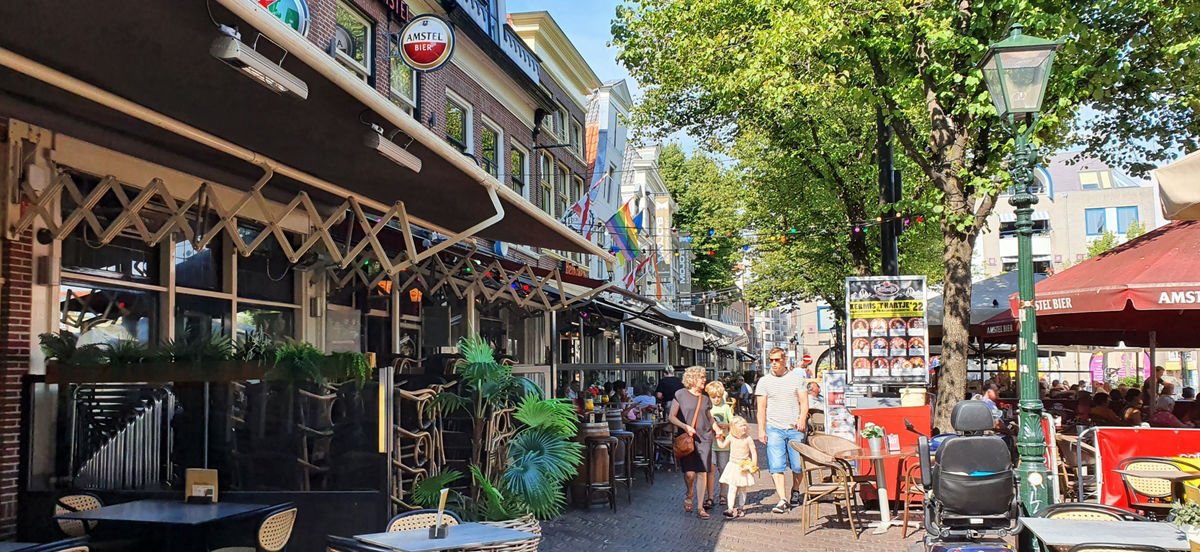
Alkmaar: a typical Dutch town

Alkmaar: a typical Dutch town
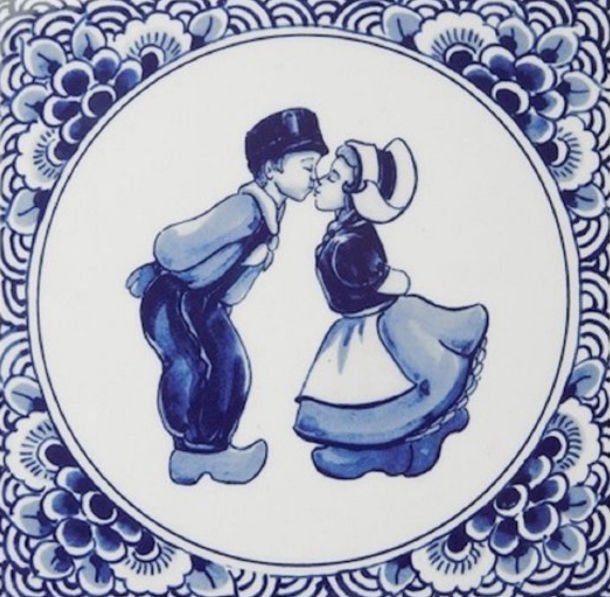
A first introduction with video:
English Arabic Turkish Ukraine Polen Bulgaria Romania Turkish
If you have a different language: important subjects in the video are:
1. Many Dutch people no longer go to a church and rules that are often prescribed by the church and adopted by law have been very weakened. For example, abortion is allowed. You can ask your doctor for the rules regarding abortion.
2. Sometimes people have reached an end stage in their lives where they suffer a lot of pain. A doctor can then help to end the life. We then speak of euthanasia.
3. Many people are divorced in the Netherlands. That is fully accepted.
4. Marriage between man and man or woman and woman is officially possible in the Netherlands.
5. You can also live together in the Netherlands without being married. It is possible to make a cohabitation agreement.
6. Unlike some other countries, you are not allowed to hit your partner or children in the Netherlands. We call that domestic violence
7. In the Netherlands, a boy may be circumcised, but circumcision of a girl is strictly prohibited.
8. Sex between an adult and anyone under the age of 16 is prohibited. Sex under duress is prohibited and is considered rape. A ban on not having sex before marriage is seen by most as nonsense.
9. In the Netherlands we see that people live in their home as long as possible. Even if their partner has passed away. This means that many elderly people are lonely.
<<<

internet: more information
There are several holidays in the Netherlands, each of which has its own meaning. Below are the main holidays and what people often do during these days:
<<<
•
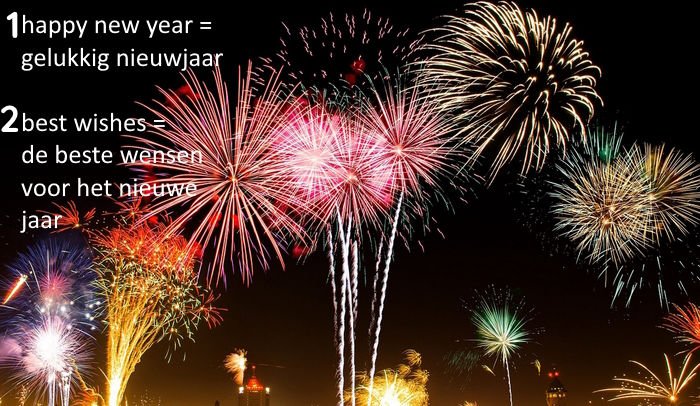
New Year
New Year's Day (January 1)
This is the first day of the new year and many people celebrate it with family or friends. People wishes each other all the best for the new year.
1. happy new year
2. best wishes for the new yesr
<<<
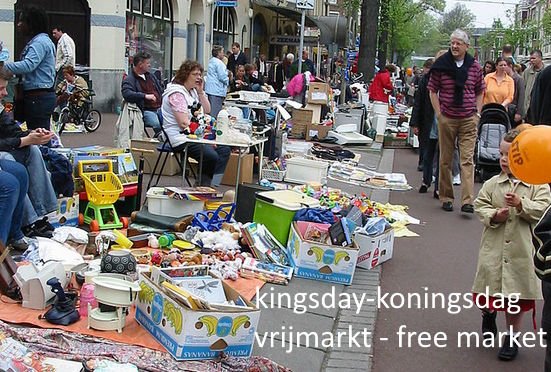
kings day
King's Day (April 27)
This is King Willem-Alexander's birthday and is celebrated with parties, markets and festivals. You see the color orange everywhere and people sell second-hand stuff on the free markets, which are markets where everyone can stand.
<<<
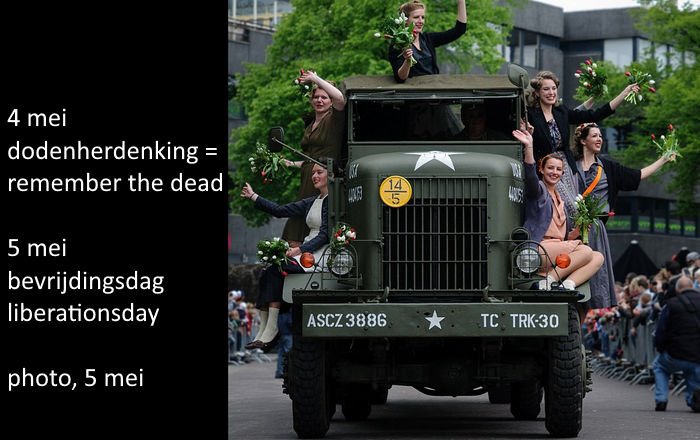
liberation
Remenbrance day and liberation day
May 4
Before Liberation Day, there is an important day called Remembrance Day, which falls on May 4. On this day, we take time (1 minute silence at 8 PM) to remember and honor the victims of wars in general. It's a day to reflect on the impact of wars and to show respect for those who have suffered because of them.
Remembrance day in Dutch means remember the people that died:
May 5
Liberation Day (May 5): The day after Remembrance day. This is a special day in the Netherlands. It marks the liberation of the country from the German occupation during World War II in 1945. On this day, we celebrate the fact that we are now a free country. Liberation Day is celebrated with festivals and activities that honor and celebrate freedom.
Liberation day in Dutch is:
<<<
Christmas
Christmas (December 25 and 26): Christmas is a very important holiday, especially for Christians. It is a special day to celebrate the birth of Jesus Christ. Christians go to church and spend time with their family and friends. However, nowadays, it has also become a typical "family-day" for people who are not Christians.
During Christmas, people often have big meals together and exchange gifts. Many people also decorate a Christmas tree in their homes with ornaments, garlands, and lights. It's a festive time when families come together to enjoy each other's company and celebrate the holiday spirit.
<<<
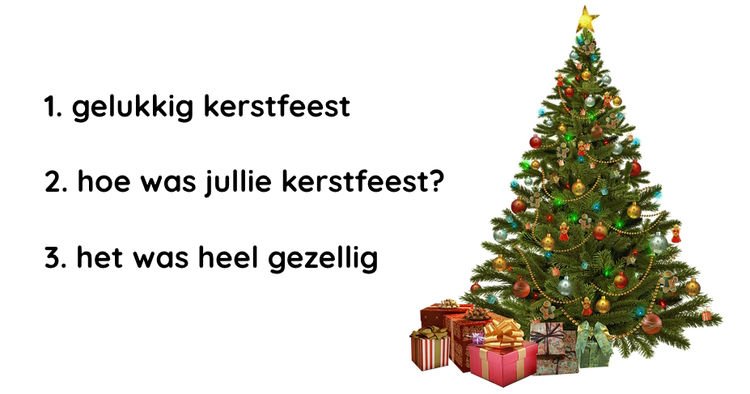
1 Merry Christmas
2 how was your christmas?
<
3 it was very pleasant
<<<
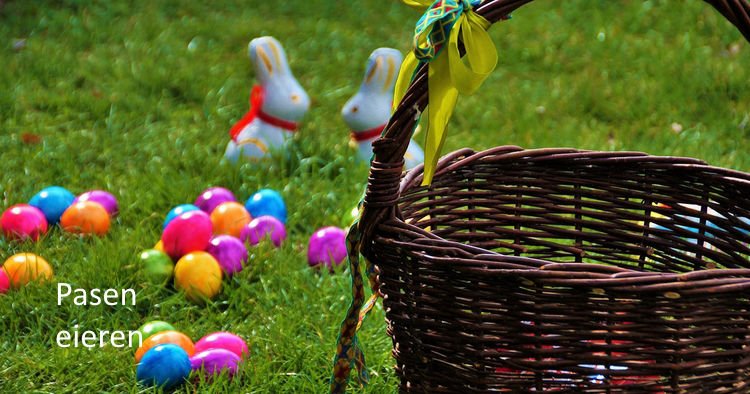
Easter (date varies by year)
Easter is a holiday celebrated by Christians to remember the coming back to live of Jesus Christ. Many Christians attend church services and spend time with their loved ones on this day. However, in the Netherlands, Easter is also a national holiday. This means that everyone has a day off on Sunday and the following Monday. It's a time when people have the opportunity to visit their relatives and enjoy delicious food together.
A popular Easter tradition is an egg hunt, where eggs are hidden, often in a garden, and children search for them. It's a fun activity that adds excitement to the celebration of Easter.
<<<
Carnaval
Carnival, also known as "Carnaval" in Dutch, is a festival celebrated in the southern part of the Netherlands, mainly in the provinces Noord-Brabant and Limburg. It happens before a period of fasting, and is a time of fun and celebration. By the way, not many people in the Netherlands actually fast after Carnival.
During Carnival, people wear costumes and masks, and there are parades and street parties. The festival has a tradition of humor and making fun of things, including politics. The parades often have funny and satirical themes.
<<<

Summer and winter vacation
The longest vacation is the summer vacation. Families often go to southern countries because it is warmer there. France and Spain are very popular.
The second major holiday is winter holidays. It usually runs from Christmas through the first week of the new year.
<<<
Birthday
The Dutch name for this day is "verjaardag":
When it's your birthday, you get presents and especially young children eat cake with candles on it. If a child is seven then there are 7 candles on it. There is also a special song called "Lang zal die leven". It is sung at home, at school or at work and you often give something tasty. Children sometimes have party. Family and friends come to visit to congratulate the birthday person.
Usually you give a small present.
<<<

1: congratulaions
2. with your birthday
<<<
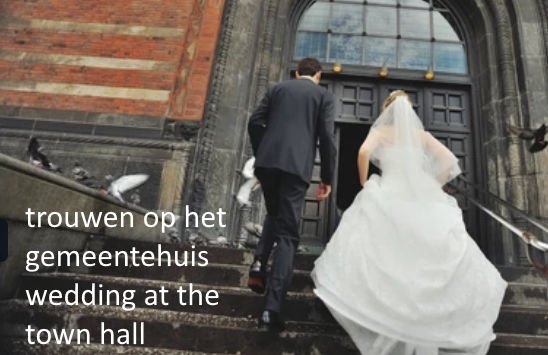
Marriage
The Dutch word for marriage is: "huwelijk":
When two people decide to get married, they celebrate their wedding. They send invitations to their family and friends. The bride usually wears a white dress, and the groom wears a suit. The wedding ceremony takes place at the town hall (also known as the "gemeentehuis"), and for religious people, it may also be held in a church. After the ceremony, there is a reception where people congratulate the couple, and in the evening, there is often a party to celebrate. The "just married" couple often goes on a honeymoon afterwards.
Living together
The Dutch expression for living together is : "samen leven":
It's worth noting that many people in the Netherlands choose to live together without getting married. Additionally, in the Netherlands, it is also possible for two men or two women to legally marry each other.
<<<
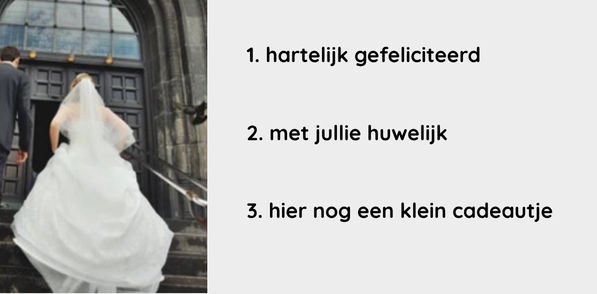
1. congratulations
2. with your marriage
If you are invited to the partij you cam bring a present, for instance related to the country where you come from. People always like such a present:
3. here is a small gift
<<<
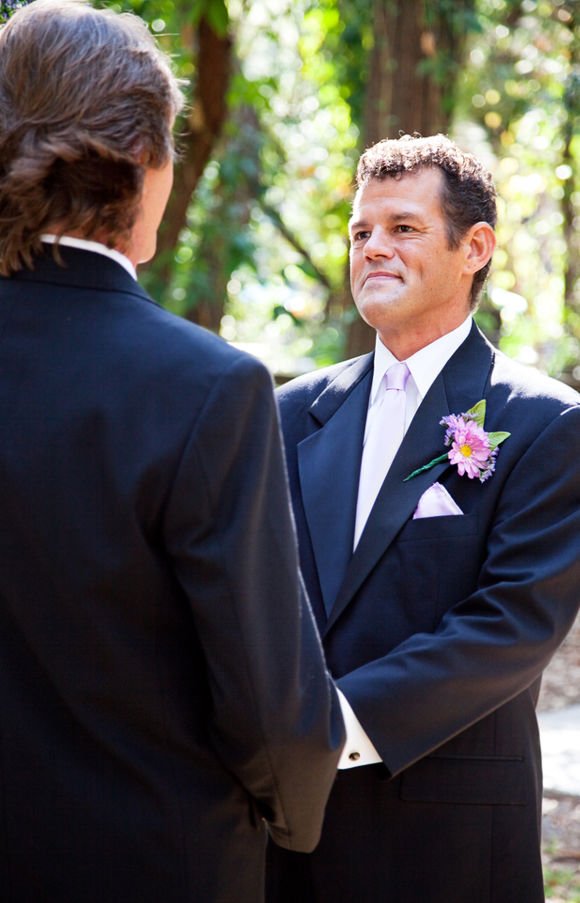
same-sex marriage accepted in the Netherlands
In the Netherlands, same-sex marriage has been legal since 2001. It means that two people of the same sex can get married and have their marriage recognized by the law, just like a man and a woman. They have the same rights and responsibilities as any other married couple, including adopting children and receiving legal protections.
The Netherlands was the first country to legalize same-sex marriage, which was an important step for LGBTQ+ rights. Many other countries have since followed this example.
In the Netherlands, most people are accepting and supportive of same-sex marriage. It has helped create a more inclusive society where everyone is treated equally, regardless of their sexual orientation.
While some people may still have different opinions about same-sex marriage, the law in the Netherlands ensures that same-sex couples have the right to marry and enjoy the same benefits as any other married couple.
<<<
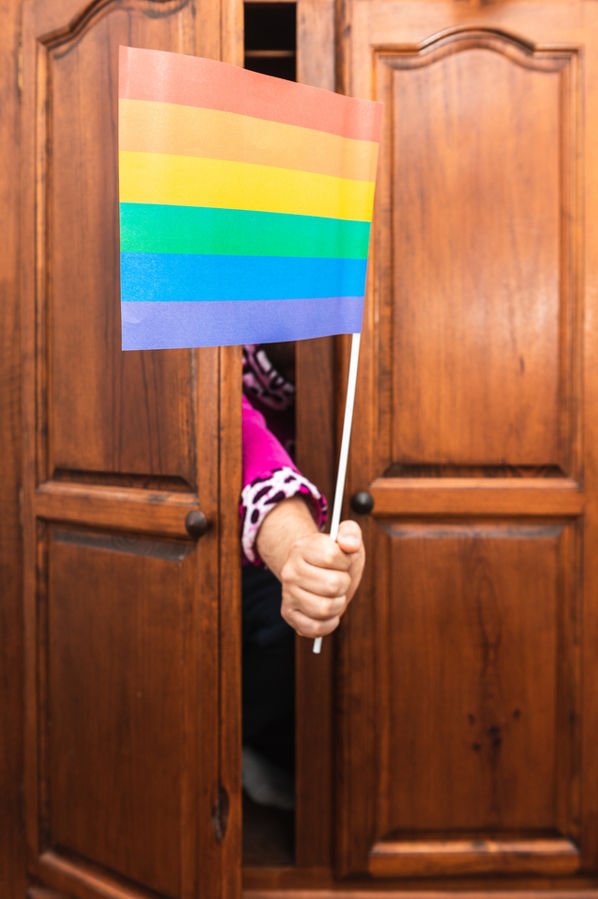
LGBTQ+ When someone says that they are homosexual, sometimes we use the phrase "coming out." It means that they are sharing their true feelings and identity with others. It can be a big and brave step for them to be honest about who they are.
LGBTQ+ is a term that includes different types of people. It stands for lesbian, gay, bisexual, transgender, and queer. The "+" means that there are other types of people who are also part of this community.
Here's what each term means:
Lesbian: This word is used for women who are attracted to other women.
Gay: This word is often used for men who are attracted to other men, but it can also include women.
Bisexual: This means someone who is attracted to both their own gender and other genders.
Transgender: This is when someone feels that their gender identity is different from the sex they were assigned when they were born.
Queer: This is a word that includes many different types of people who don't fit into traditional categories. It can be used by people who don't feel they fit into one specific group.
The "+" at the end means there are other types of people who are also part of the community, even if they're not specifically mentioned. It's important to remember that everyone is unique, and these terms help us understand and respect each other's differences.
<<<
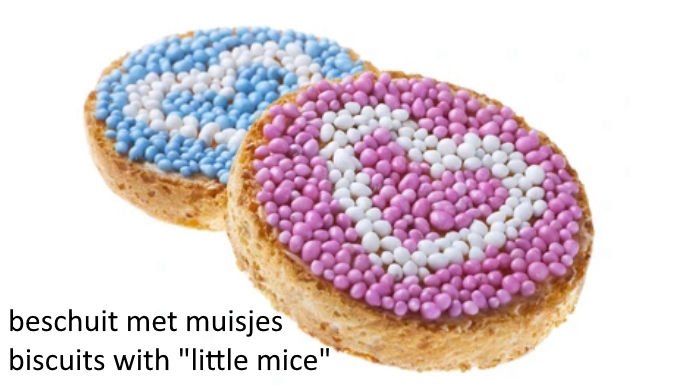
blue = male , pink = female
Birth
The Dutch expression is "geboorte":
When a baby is born, it sometimes happens in the hospital and sometimes at home. The parents send cards to family and friends to share the good news. When visitors come, an appointment often has to be made first, because the mother and baby need rest. Visitors often receive biskuits (special large cookie) with small sweet (blue or pink). The Dutch expression is "beschuit met muisjes".
When a baby is born in the Netherlands, there are several typical customs and traditions:
Birth Announcements: Parents often send out birth announcements to family, friends, and acquaintances to share the joyous news of their baby's arrival. These announcements usually include the baby's name, birth date, and sometimes a photo.
Visiting the Newborn: Family, friends, and loved ones visit the new parents and baby to offer their congratulations and well wishes. It is customary to bring a gift for the baby, such as clothing or toys.
"Beschuit met muisjes":
A popular Dutch tradition is serving "beschuit met muisjes" to celebrate the birth. This is a round, crisp biscuit topped with sugared anise seeds. Pink and white muisjes (candy-coated anise seeds) are typically used for a baby girl, while blue and white muisjes are used for a baby boy.
"Kraamzorg":
In the Netherlands, new parents often receive professional maternity care called "kraamzorg." A kraamverzorgster (maternity nurse) provides support and assistance to the new mother and helps with the care of the baby during the first week or two after birth.
These customs may vary from family to family, but they represent some common practices when a baby is born in the Netherlands.
<<<
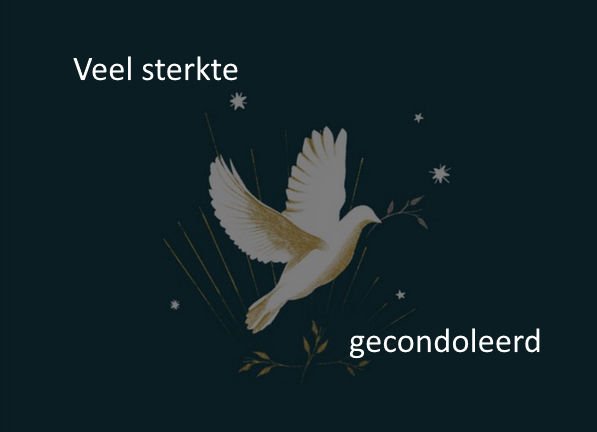
Condolences
Passing away
The Dutch word is "overlijden":
When someone passes away in the Netherlands, there are typical customs to remember:
Offering Condolences: Friends, family, and others express sympathy to the family by visiting their home or attending a special meeting. They offer kind words and support during this difficult time.
Funeral Services: Funerals can vary based on personal and religious preferences. They may happen at a church, crematorium, or cemetery. The ceremony includes speeches, prayers, music, and moments to remember and honor the person who passed away.
Condolence Register: At the funeral or gathering, there is a book where people can write their names and leave messages of sympathy for the family. This allows those who couldn't attend the funeral to express their condolences.
Funeral Flowers: It's common to send flowers to the funeral as a way to show sympathy and respect for the deceased. The flowers are displayed during the ceremony and may be placed on the grave or cremation site afterwards.
Mourning Period: The immediate family may observe a period of mourning after the loss. This is a time for them to grieve privately and reflect on their loss. The length of this period can vary for each family.
Thank You Cards: After the funeral, the family may send thank-you cards to those who offered condolences, attended the funeral, or sent flowers. These cards express gratitude for the support they received during their time of grief.
It's important to remember that customs may vary based on personal beliefs, culture, and religion. These are general customs observed in the Netherlands when someone passes away, but individual families may have their own unique traditions and rituals.
<<<
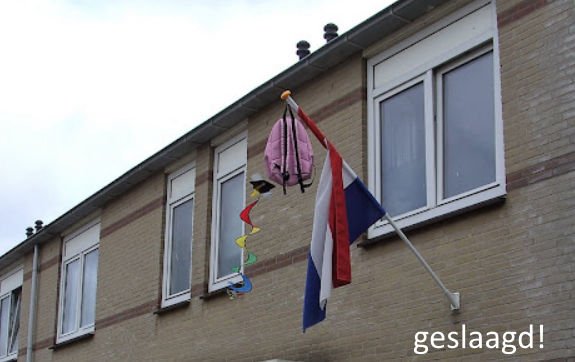
congratulations... you passed the exam
Pass exam
The Dutch expression is "slagen voor het examen":
When someone passes an exam in the Netherlands, there are common ways to celebrate:
Congratulations: Friends and family congratulate the person on their success with kind words and messages.
Treats: The person who passed the exam often treats their loved ones to something special, like coffee and cake or a celebration at a restaurant or home.
Displaying Flags: Sometimes, for important exams like high school or university graduations, you may see the Dutch flag and a schoolbag displayed outside the person's home as a sign of celebration.
Gifts: Family and close friends may give the person gifts to honor their achievement. These gifts can have special meaning or be related to their interests.
Social Media Announcements: Many people share their exam success on social media, expressing happiness and gratitude for the support they received during their studies.
These customs can vary depending on the person and the exam's importance. Some celebrations may be more private, while others involve larger gatherings or parties. The main idea is to recognize the person's accomplishment and offer support for their future endeavors.
<<<
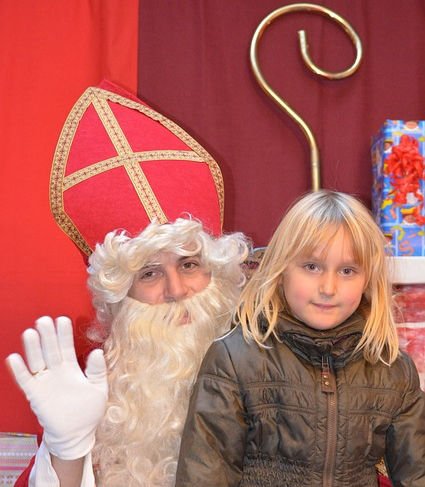
Foto Ben Kerckx Pixabay
Sinterklaas is a special children's party celebrated every year on December 5 in the Netherlands. During this celebration, a person called Sinterklaas appears along with his helpers called Pieten. They help Sinterklaas give out gifts and sweets. Sinterklaas dresses up like a priest and the children are told that he comes from Spain to the Netherlands every year. They arrive by boat, and then Sinterklaas rides on a horse through the city. Children put their shoes near the fireplace or stove, hoping that Sinterklaas will leave a present in them. Some popular treats during Sinterklaas are pepernoten (spiced cookies) and chocolate letters.
Sinterklaas is also a topic of discussion in the Netherlands, especially regarding the tradition of Zwarte Pieten (Black Petes), the helpers of Sinterklaas. This tradition is controversial because it contains elements related to historical slavery. To address this concern, in many cities, the helpers are portrayed in various colors instead of just black. This change aims to make the celebration more inclusive and respectful to all.
<<<
What to do?

congratulations or condolences
In the Netherlands, there are certain customs and etiquettes surrounding the giving of congratulations or condolences. Here is some more information:
In the Netherlands, there are certain customs and gestures to congratulate or offer condolences to someone. Here are some common practices:
To Congratulate:
Verbal congratulations: Simply expressing your congratulations and well wishes to the person is appreciated. You can say "Gefeliciteerd!" (Congratulations!) and offer a warm message of support and happiness for their achievement or milestone.
Gifts: Offering a small gift to congratulate someone is a thoughtful gesture. It could be a bouquet of flowers, a bottle of wine, or a personalized gift that reflects their accomplishment or interests.
Cards: Sending a congratulatory card is a popular way to express your congratulations. You can find cards specifically designed for various occasions, and you can write a personal message inside to convey your heartfelt wishes.
To Offer Condolences:
Verbal condolences: When offering condolences, you can say "Gecondoleerd" (Condolences) and express your sympathy and support for the grieving person. You can also offer comforting words or simply let them know that you are there for them.
Sympathy cards: Sending a sympathy card is a common way to express condolences. You can find cards specifically meant for offering sympathy and write a heartfelt message inside to show your support and empathy.
Flowers: Sending a bouquet of flowers, especially white or soft-colored blooms, is a traditional way to express condolences in the Netherlands. It represents your sympathy and offers comfort to the grieving family.
Attending the funeral or memorial service: If appropriate and if you have a close relationship with the grieving person or their family, attending the funeral or memorial service is a meaningful way to offer your condolences in person. Your presence and support can provide comfort during their difficult time.
It's important to consider the cultural and individual preferences of the person you are congratulating or offering condolences to. These gestures show your care and support during both joyful and challenging moments in their lives.
<<<
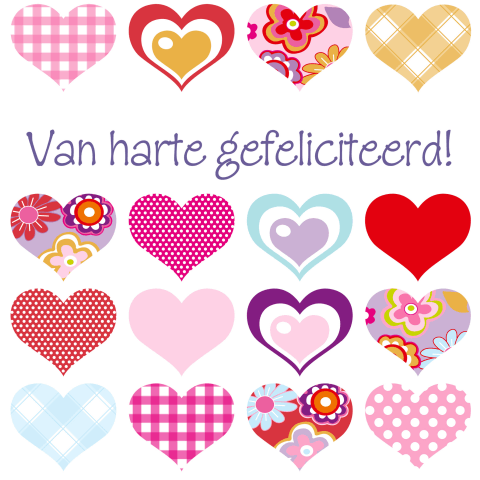
Congratulations
In the Netherlands it is customary to send someone a card on various occasions, such as:
Birthdays: It is customary to send a birthday card to friends, relatives or acquaintances to congratulate them on their birthday.
Holidays: During holidays such as Christmas, Easter and Sinterklaas, people often send cards to their loved ones to convey their good wishes.
On special events: When a special event takes place, such as a wedding, birth or graduation, it is customary to send a card to convey your congratulations.
In case of illness or condolence: When someone is ill or has passed away, sending a card can be seen as a sign of sympathy.
<<<

social kiss
In the Netherlands, people sometimes greet each other by kissing on the cheek as a way of being friendly. But it's important to know that not everyone does this, and it depends on the person and the situation. Here are some things to keep in mind:
Three kisses: In many parts of the Netherlands, it's common to give three light kisses on the cheek when greeting friends, family, or acquaintances. The pattern is usually right cheek, left cheek, and then right cheek again.
Gender and familiarity: The three-kiss greeting is often done between people of different genders or women. However, among male friends or acquaintances, it's more common to shake hands or just nod as a greeting. Some men may still give a single cheek kiss, though.
Variations: While three kisses are typical, some people might prefer fewer kisses, like two or even just one. In more formal or professional settings, a handshake is usually the preferred greeting.
Respecting personal boundaries: It's important to respect others' personal space and comfort levels when it comes to physical greetings. If you're unsure, it's perfectly fine to just give a friendly nod, smile, or handshake instead of a kiss.
Overall, kissing customs in the Netherlands can vary depending on the people and the situation. It's important to be observant and considerate of others' preferences to show respect and maintain personal boundaries.
<<<
Visit and bring a gift
The Dutch word for visit is "bezoek":
When you visit, you can bring a gift or flowers, for example for new neighbors or for a party. At a birthday, wedding or birth, people give gifts, for instance a gift card. If you want to thank someone, you can give a gift, flowers or a gift card, but not money. Gifts are not expensive and people open them right away.
If you have an appointment
The Dutch word for appointment is "afspraak":
If you have an official appointment, such as at the hospital or for a job interview, you must arrive on time. If you are late, you may get a problem, such as a fine or you will have no job. If you can't come oryou are late, you have to call. You can write the appointment in a calendar.
<<<

doctor (photo: granderboy via Pixabay)
When attending a formal meeting in the Netherlands, like visiting a doctor, there are important things to remember:
Be on time: It's important to arrive at your appointment on time to show respect for the doctor's schedule. The Dutch expression for be on time is "op tijd zijn":
Schedule and changes: Make appointments in advance and let the doctor's office know if you need to reschedule or cancel. Try to give them at least 24 hours' notice.
Bring necessary documents: Bring any documents related to your medical history or previous treatments to help the doctor understand your situation.
Privacy and confidentiality: Your health matters are private, and doctors in the Netherlands have strict rules to keep your information confidential. Feel free to ask about privacy or any concerns you have.
Remember, specific instructions may vary depending on the healthcare provider, so it's good to check with the doctor's office for any additional information or requirements.
<<<
Start a website with Mobirise